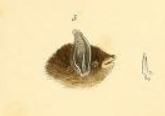| Silver-tipped myotis | |
|---|---|

| |
| Scientific classification | |
| Domain: | Eukaryota |
| Kingdom: | Animalia |
| Phylum: | Chordata |
| Class: | Mammalia |
| Order: | Chiroptera |
| Family: | Vespertilionidae |
| Genus: | Myotis |
| Species: | M. albescens
|
| Binomial name | |
| Myotis albescens Geoffroy, 1806
| |

| |
| Silver-tipped Myotis Bat range | |

The silver-tipped myotis (Myotis albescens) is a species of mouse-eared bat found in a range of lowland habitats in the Americas.
It is part of the vesper bat genus Myotis, which includes many common species across the world. Genetic analysis suggests that it is probably most closely related to a group of Neotropical Myotis species that includes Myotis nigricans, Myotis levis, and Myotis oxyotus,[2] or alternatively to Myotis dominicensis alone.[3]
Description
[edit]The silver-tipped myotis is a small bat, with a total length of 7.9 to 9.6 centimetres (3.1 to 3.8 in), and a tail 2.7 to 4.0 centimetres (1.1 to 1.6 in) long.[4] The fur is long and silky, with individual hairs being black or dark brown for most of their length, but white at the tips. This silver ticking gives the bat its common name and "frosted" appearance. Although fur with a similar pattern is found on the undersides of some related species, only in the silver-tipped myotis does it extend across the entire body, thus enabling it to be distinguished from some otherwise very similar bats.[5]
The undersides and legs of the animal are paler than the rest of the body, and the bare skin of the wings varies from light brown to almost black, depending on the individual. The bat has a rounded head with narrow, pointed ears, and unusually large feet. The membranes of the wings attach to the toes at their hindmost part, while the membrane between the legs is partially supported by a long calcar that actually extends beyond its edge to end in a small rounded lump.[5]
Distribution
[edit]The silver-tipped myotis is one of the most widespread members of its genus, being known from every country of South America except Chile and French Guiana.[5] It is possible that it does occur in French Guiana, but has not yet been recorded.[6] In the northern part of its range it is found in Panama, Costa Rica, Nicaragua, Honduras, Guatemala, and parts of Chiapas and Veracruz in southern Mexico.[7] Its wide range is partly due to a tolerance for a wide range of lowland habitats, including forests, shrublands, open wetlands, and pasture below 500 metres (1,600 ft) elevation.[5] However, it usually occurs near open water.[6] It is absent in the Andes and in the colder environments of central and southern Argentina.[5]
There are no recognised subspecies.
Behavior
[edit]Like most bats, silver-tipped myotises are nocturnal, and are most active immediately after sunset and before dawn. They spend the day roosting in small groups in holes or crevices in trees or cliffs, typically close to water. They are not cave-roosting bats, preferring more open environments with some degree of ventilation and light. In more settled areas, they are commonly found roosting under roofs, or inside attic spaces. Although they may occasionally become torpid during cold nights, they do not hibernate.[5]
They have been reported to feed on beetles, flies, lepidopterans, and spiders.[8] They are generally slow flying bats,[9] flying low to the ground or water, and grabbing insects with their large feet.[10] While hunting, they have been reported to use short, 2 to 5 millisecond, frequency modulated calls, sweeping down from 75 to 43 kHz, at sound levels of up to at least 111 dB.[11]
Reproduction
[edit]Males and females roost together, and the females are promiscuous, mating with several of their partners. There is no particular breeding season over most parts of the range, and females typically give birth to two or three young every year. Fertilisation does not occur for up to three months after mating indicating that females can likely store sperm in their bodies for this time, thus being able to control the timing of their pregnancy.[5] Gestation lasts about three months, and results in the birth of a single young.[5]
The young are weaned at about one month of age, by which time all their permanent teeth have erupted. Females become sexually mature at just two months, although males are not fertile for six or seven months after birth.[5]
References
[edit]- ^ Barquez, R.; Diaz, M.; Samudio Jr, R.; Arroyo-Cabrales, J. (2016). "Myotis albescens". IUCN Red List of Threatened Species. 2016: e.T14140A22049892. doi:10.2305/IUCN.UK.2016-1.RLTS.T14140A22049892.en. Retrieved 12 November 2021.
- ^ Stadelmann, B.; et al. (2007). "Molecular phylogeny of New World Myotis (Chiroptera, Vespertilionidae) inferred from mitochondrial and nuclear DNA genes". Molecular Phylogenetics and Evolution. 43 (1): 32–48. doi:10.1016/j.ympev.2006.06.019. PMID 17049280.
- ^ Lack, Justin B.; Roehrs, Zachary P.; Stanley, Craig E.; Ruedi, Manuel; Van Den Bussche, Ronald A. (2010). "Molecular phylogenetics of Myotis indicate familial-level divergence for the genus Cistugo (Chiroptera)". Journal of Mammalogy. 91 (4): 976–992. doi:10.1644/09-MAMM-A-192.1.
- ^ López-González, C.; et al. (2001). "Taxonomic status of Myotis (Chiroptera: Vespertilionidae) in Paraguay". Journal of Mammalogy. 82 (1): 138–160. doi:10.1644/1545-1542(2001)082<0138:TSOMCV>2.0.CO;2.
- ^ a b c d e f g h i Braun, J.; et al. (2009). "Myotis albescens (Chiroptera: Vespertilionidae)". Mammalian Species. 846: 1–9. doi:10.1644/846.1.
- ^ a b Simmons, N.B. & Voss, R.S. (1998). "The mammals of Paracou, French Guiana: a Neotropical lowland rainforest fauna. Part 1. Bats". Bulletin of the American Museum of Natural History. 237: 1–219. hdl:2246/1634.
- ^ Simmons, N.B. (2005). "Order Chiroptera". In Wilson, D.E.; Reeder, D.M (eds.). Mammal Species of the World: A Taxonomic and Geographic Reference (3rd ed.). Johns Hopkins University Press. pp. 312–529. ISBN 978-0-8018-8221-0. OCLC 62265494.
- ^ Whitaker, J.O. & Findley, J.S. (1980). "Foods Eaten by Some Bats from Costa Rica and Panama". Journal of Mammalogy. 61 (3): 540–544. doi:10.2307/1379850. JSTOR 1379850.
- ^ Aguirre, L.F. (2002). "Structure of a Neotropical savanna bat community". Journal of Mammalogy. 83 (3): 775–784. doi:10.1644/1545-1542(2002)083<0775:SOANSB>2.0.CO;2.
- ^ Fenton, M.B. & Bogdanowicz, W. (2002). "Relationships between external morphology and foraging behaviour: bats in the genus Myotis". Canadian Journal of Zoology. 80 (6): 1004–1013. doi:10.1139/z02-083.
- ^ Surlykke, A. & Valko E.K.V. (2008). "Echolocating bats cry out loud to detect their prey". PLOS ONE. 3 (4): e2306. Bibcode:2008PLoSO...3.2036S. doi:10.1371/journal.pone.0002036. PMC 2323577. PMID 18446226.
